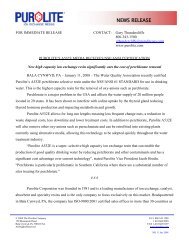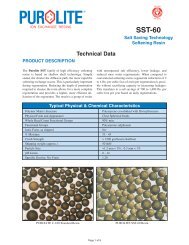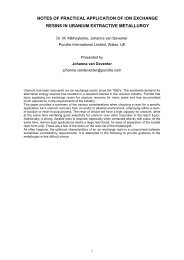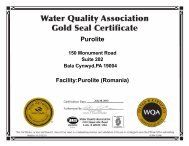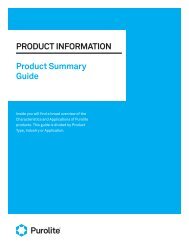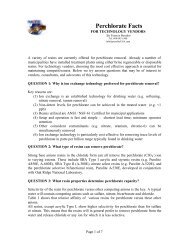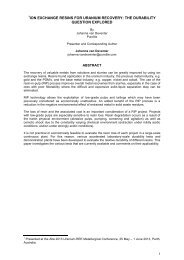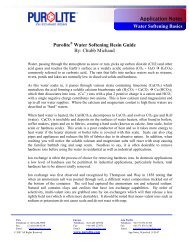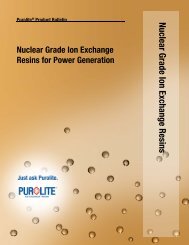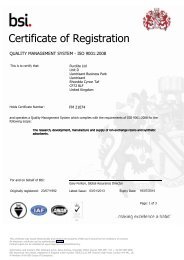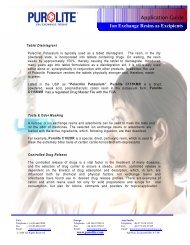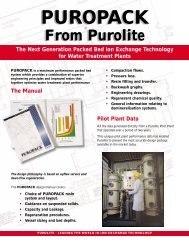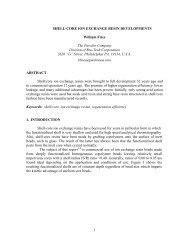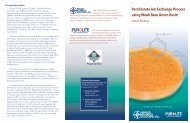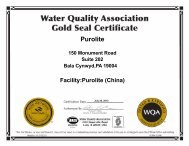Cane Sugar Refining - Purolite
Cane Sugar Refining - Purolite
Cane Sugar Refining - Purolite
You also want an ePaper? Increase the reach of your titles
YUMPU automatically turns print PDFs into web optimized ePapers that Google loves.
45<br />
GRAM-MILLIEQUIVALENTS: The equivalent<br />
weight in grams, divided by 1000.<br />
GEL: Ion exchange resins that are made up<br />
of firm gel structure in a solid bead form<br />
allowing for the diffusion of ions through<br />
the gel.<br />
HARDNESS: The scale-forming and latherinhibiting<br />
qualities which water, high<br />
in calcium and magnesium ions, possesses.<br />
Temporary hardness, caused by the<br />
presence of magnesium or calcium<br />
bicarbonate, is so called because it may<br />
be removed by boiling the water to<br />
convert the bicarbonates to the insoluble<br />
carbonates. Calcium sulfate, magnesium<br />
sulfate, and the chlorides of these two<br />
metals cause permanent hardness.<br />
HARDNESS AS CALCIUM CARBONATE: The<br />
expression ascribed to the value obtained<br />
when the hardness forming salts are<br />
calculated in terms of equivalent quantities<br />
of calcium carbonate; a convenient method<br />
of reducing all salts to a common basis<br />
for comparison.<br />
HEADLOSS: The reduction in liquid pressure<br />
associated with the passage of a solution<br />
through a bed of exchange material; a<br />
measure of the resistance of a resin bed to<br />
the flow of the liquid passing through it.<br />
HYDRAULIC CLASSIFICATION: The rearrangement<br />
of resin particles in an ion exchange<br />
unit. As the backwash water flows up<br />
through the resin bed, the particles are<br />
placed in a mobile condition wherein<br />
the larger particles settle and the smaller<br />
particles rise to the top of the bed.<br />
HYDROGEN CYCLE: A complete course of<br />
cation exchange operation in which<br />
the adsorbent is employed in the hydrogen<br />
or free acid form.<br />
<strong>Cane</strong> <strong>Sugar</strong> <strong>Refining</strong> with Ion Exchange Resins<br />
HYDROXYL: The term used to describe the<br />
anionic radical (OH-) which is responsible<br />
for the alkalinity of a solution.<br />
HYDROXYMETHYL FURFURAL, HMF:<br />
5 (Hydroxymethyl) -2-furaldehyde, a<br />
precursor of the coloring matter from the<br />
decomposition of glucose and also thereby<br />
assisting in the color development in<br />
sugars. HMF is produced during contact<br />
with strong acid cation resins in H+ form<br />
at elevated temperatures.<br />
INFLUENT: The solution which enters an ion<br />
exchange unit.<br />
ION: Any particle of less than colloidal size<br />
possessing either a positive or a negative<br />
electric charge.<br />
IONI2ATION: The dissociation of molecules<br />
into charged particles.<br />
IONIZATION CONSTANT: An expression in absolute<br />
units of the extent of dissociation into<br />
ions of a chemical compound in solution.<br />
ION EXCHANGE: See fundamental description<br />
beginning page 8.<br />
KILOGRAIN: A unit of weight; one thousand<br />
grains.<br />
LEAKAGE: The phenomenon in which some<br />
of the influent ions are not adsorbed or<br />
exchanged and appear in the effluent<br />
when a solution is passed through an<br />
under-regenerated exchange resin bed.<br />
MACROPOROUS: Resins that have a rigid<br />
polymer porous network in which there<br />
exists a true pore structure even after drying.<br />
The pores are larger than atomic distances<br />
and are not part of the gel structure.



